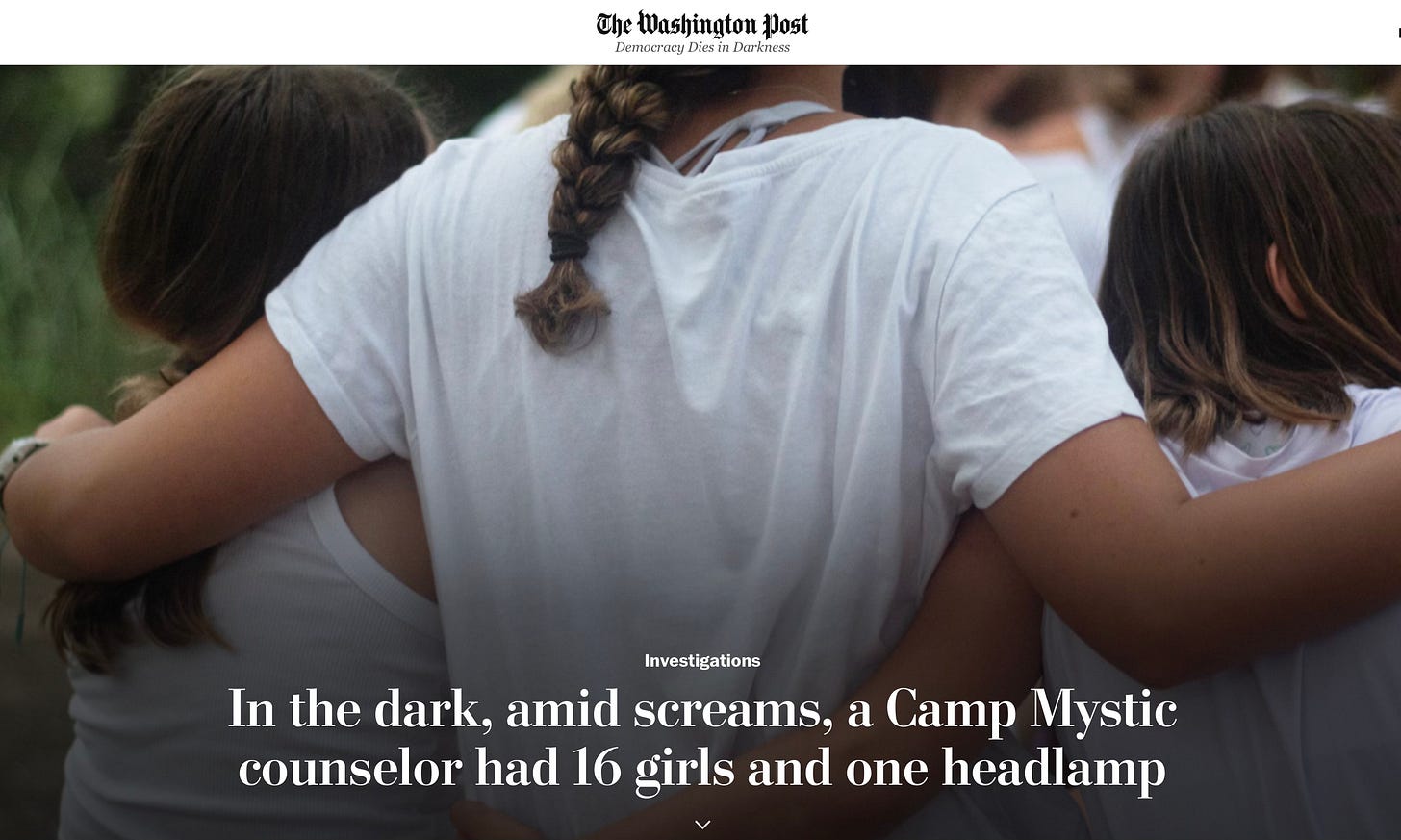10 tips for writing scene-driven narrative nonfiction
Drawn from a Washington Post story about Camp Mystic.
Whenever tragedy strikes, my first instinct as a journalist is to turn to the news. Journalism has always helped me to not just be informed (through hard news stories) but to feel a greater sense of connection with issues, people, and places (through longform feature stories).
I’ve found this to be true over the past two weeks as I’ve followed coverage of the Texas Hill Country rivers that quickly rose and unleashed floodwaters, killing more than 100 people and leaving many still missing.
There are two longform pieces in particular that resonated with me last weekend— a personal essay written by Texas Monthly editor Aaron Parsley, and a scene-driven narrative about a Camp Mystic counselor, written by The Washington Post’s John Cox and edited by Kelley Benham French.
The personal essay details Parsley’s and his family’s harrowing efforts to escape their river house, which was destroyed by the flooding. The story came together quickly, and it’s an extraordinary read.
So too is Cox’s piece, which details how Camp Mystic counselor Ainslie Bashara led her campers to safety in the face of life-threatening flooding. The piece is an example of scene-writing at its best, and it’s a powerful testament to the type of storytelling that can unfold when journalists do in-depth reporting that helps us see a tragedy through the eyes of those affected.
Both pieces are worth reading and analyzing, but for today’s newsletter post I’m taking a deep dive into the story by Cox, who I know and have written about before. I suggest you read the story first and then shift your attention to these 10 takeaways about how to write scene-driven narrative nonfiction that’s based off the news.
1.) CONSIDER HOW NATURE CAN ACT AS A CHARACTER. Cox’s story begins with the root cause of the tragedy: water. In the lead sentence, we learn that “the first drops of rain had yet to fall” when Ainslie heard her campers crying after lightning struck.
As we move deeper into the story, water becomes its own character of sorts. In subsequent paragraphs, we see “ran spit sideways through the windows” of the cabin where Ainslie’s campers were staying. Midway through the story, rain turns into something more ominous — cold, deep water that threatens everything in its path. We learn that the water was “rushing past with such force it felt like rapids,” and that it later “had surged.”
Rain keeps falling throughout the story. The morning after Ainslie had led her campers to safety, “the clouds didn’t part. The rain didn’t stop.” By the story’s end, Cox explains that even after helicopter crews rescued the girls, “the rain still had not stopped.”
I couldn’t help but feel the threat of nature throughout the piece, not just because Cox tells us about it but because he shows us its devastation by returning to it as though it were a character in the narrative.
2.) SEEK OUT NAMES. In the first paragraph of the story, we learn that the name of the cabin where the story takes place is “Giggle Box.” This name is so striking; it conveys the youth of the campers and the reality that camp is supposed to be a happy place.
In the story we also get the name of the stuffed animal (Banana the Monkey) that a camper had to leave behind in her cabin. The camper prayed that the stuffed animal would be ok. Later in the story, Cox ties up this loose end, saying: “Banana the Monkey was safe on the top bunk.” This is a good reminder that if you introduce a detail that poses a question (will the stuffed animal survive the storm?) do your best to close the loop and answer it by the story’s end.
3.) CLARIFY CHRONOLOGY. The story offers up several timestamps, which makes it easier to follow the sequence of events. In the story’s second paragraph, we learn that it was just past 9 p.m. on July 3 when the campers were getting ready for bed. By 1:58 a.m., Ainslie heard shrieking. Around 3 a.m., she was desperately trying to get the girls out of their cabin, while realizing that the water threatened to sweep them all away. By 6 a.m. the next morning, the flood was receding.
These markers of time, which are seamlessly woven into the narrative, help us to more easily follow various scenes as they’re unfolding. Timestamps are especially helpful in stories like this one, which zooms in on a less-than-24-hour period.
4.) ADOPT INSIDER LANGUAGE. I appreciate how, very early on, the story clues us into Camp Mystic’s lingo. One sentence reads that it was “the start of Ainslie’s night off from tending to Giggle Box’s 16 ‘littles.’” Cox returns to this “littles” language throughout, eventually removing the quotation marks around the word. This technique can help readers feel “in the know,” and it creates a perceived closeness between reader and subject.
Cox also skillfully weaves in language that mimics scripture (another kind of insider language). He writes, for instance, that Ainslie was “devoted” to her campers and was in awe of “the spirit” of her littles. Later in the piece, he writes about how the staff “shepherded” campers to safety, and how “Ainslie wept” when she found out how many had died in the flood. Each of these quoted words has a biblical connotation, and “Ainslie wept” is symbolic of the shortest (and arguably the most poignant) verse in the Bible: “Jesus wept.”
5.) SHOW THE POWER OF JUXTAPOSITION. There was one passage in the story that stopped me in my tracks:
Hours earlier, the counselors had performed skits. One group had spoofed "Wicked” and another “Love Island,” Ainslie said, but her group had decided on “Jesus Highlights.” She played the disciple Peter, caught in a boat amid wind and waves when Jesus encouraged him to believe that he, too, would not sink.
“Fear not, Peter, for I am with you, even in the storm,” Ainslie had written in the script for the friend who played Jesus. In the skit, Chloe Childress, 19, had walked on water.
The image of the campers acting out a biblical scene involving a storm and water, juxtaposed with the reality of what would transpire just a few hours later, is heartbreaking. Two paragraphs after this passage, we learn that Chloe lost her life to the storm.
While reporting this part of the story, Cox likely asked Ainslie what she and the campers were doing in the hours leading up to the flood. When analyzing stories, it’s always helpful to consider: What questions might the reporter have asked to arrive at that juxtaposition or level of detail?
6.) REVEAL TELLING DETAILS. Telling details help us to understand a person better. Cox’s story is chock-full of them, especially in the part where he describes what was tucked inside of the bins that Ainslie brought to camp. The details convey the present (her backpack, keys, and Tecovas cowboy boots); the past (her Mystic memory box, with a Bible she’d been given 12 years ago); and the future (the 10 buttons from each birthday she spent at Camp Mystic, with plans of wearing them when she turned 20 later this month).
Reading about these belongings helped me feel a greater sense of connection to Ainslie and what she holds dear. Telling details are crucial in longform journalism; they act as a narrative engine, helping to drive a story (and thereby its readers) forward.
7.) SHOW HOW INANIMATE OBJECTS CAN CONVEY STORY AND SYMBOLISM. I was struck by the headlamp that’s mentioned in various parts of the story, including the headline (“In the dark, amid the screams, a Camp Mystic counselor had 16 girls and one headlamp.”) Ainslie’s dad had given her the headlamp to read nighttime devotionals. But she ended up using it for a far different purpose: to peer through the Giggle Box cabin window at the water rising below.
Later in the story, we learn that “Ainslie watched the power go out, then her headlamp did, too. Everything was black, but she could still hear the screams.” In many ways, the headlamp symbolized light and darkness — themes that are prevalent in scripture.
As a Catholic who grew up going to catechism classes, I couldn’t help but reflect on the connections between the headlamp and related biblical passages: “Your word is a lamp for my feet, a light on my path.” … “I am the light of the world.” … “Let there be light, and there was light.” … “The light shines in the darkness and the darkness has not overcome it.” )
The headlamp, then, serves as both a literal representation of light and darkness on the night of the storm, and a metaphorical representation of the camp’s religious focus.
8.) USE STRONG VERBS TO CREATE RHYTHM AND MOVEMENT. Cox relies on several strong verbs — a technique that helps create a sense of movement throughout the story. As a fan of alliteration, I noticed that many of the verbs begin with the word “s”: slip, slide, slink, shriek, spit, slog, swirl, surge. The use of so many “s” verbs makes the story seem more rhythmic, especially when read out loud.
When self-editing your next piece of writing, try circling and/or highlighting your verbs. This will force you to pay greater attention to them and to more readily spot redundancies. Consider how you can switch up your verbs and strengthen them in service of helping your story have rhythm and movement.
Also pay attention to adjectives and make sure they’re serving a purpose. Cox does this skillfully. In one part of the story, he writes about how, the morning after the storm, “a gray light began to reveal the devastation below.” The adjective gray is especially powerful because it symbolizes the space in between the light and darkness previously described.
9.) CONSIDER THE POWER OF SHORT SENTENCES. I couldn’t help but notice that nearly every sentence in Cox’s story is on the shorter side. I appreciated this as a reader and think there’s power in short sentences — particularly when writing about children and tragedy.
It wouldn’t have made sense to use a lot of formal language, highfalutin words, or long and drawn-out sentences in a story about children. Short sentences are more in line with the way that children think and talk — and they therefore help us to more easily see the story through a child’s eyes.
Short sentences are also especially helpful in tragic news stories. When people read about tough topics, they don’t want a heavy lift (aka dense paragraphs that are bogged down by long sentences and big words). The subject matter in this story is hard enough to read about; Cox eases the burden by using shorter sentences that are more digestible and accessible.
10.) WRITE QUIET, CYCLICAL ENDINGS. The story ends with a paragraph about a group of Camp Mystic counselors flying away in a rescue helicopter:
As the helicopter ascended, the few counselors who still had phones soon began to receive cell service. As they did, posters of the missing children appeared on their screens. The young women gripped each other’s hands. They bowed their heads.
This sense of touch is reflective of the story’s lead, which shows Ainslie’s efforts to comfort a camper who is scared about the storm. (“The girl feared what was coming, so Ainslie wrapped an arm around her.”) The best endings are cyclical; they return to a moment, a sensation, or a character from the lead and help remind us how the story began and where it ended up.
In the midst of tragedy, the best endings also reflect quiet moments of hope: the rising of the sun, the breath of a baby, the bowing of a head. Cox’s scene-driven narrative takes us inside a dark room, but its ending cracks open the bedroom door, letting in a sliver of light.
I’d love to hear your thoughts. In what way did the story (and/or these tips) resonate with you?
Reminder: You still have time to enter a free giveaway for my book SLIP. Anyone who has pre-ordered the book by July 18 is eligible to win a special journal and writing prompts. You can find more details here.






too bad we can't read the post story....